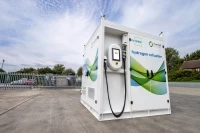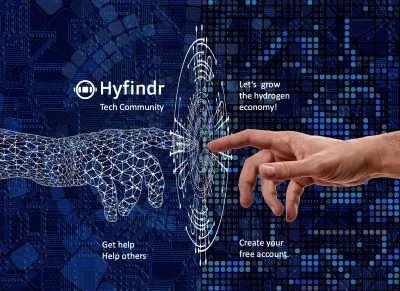- Why are hydrogen refueling stations so important for the hydrogen economy?
- How does a hydrogen refueling station work?
- What types of hydrogen filling station exist?
- Why was the roll-out of the public network of hydrogen stations for fuel cell electric vehicles progressing relatively slow?
- Which are the key technical components of a hydrogen station?
- List of some suppliers of hydrogen refueling stations
- Where can I find further information on hydrogen refuelling stations worldwide?
- Some Android apps and iOS apps provide information on the nearest hydrogen fueling station
Browse all hydrogen refueling stations from leading suppliers on our marketplace!
Why are hydrogen refueling stations so important for the hydrogen economy?
Fuel cell electric vehicles are converting hydrogen into electricity through their fuel cell system. Without efficient hydrogen refueling systems such vehicles do not provide an attractive use case. The fuel cell system is constantly converting hydrogen into electricity and generally recharges a small integrated battery that is used for energy buffering and peak performances. The hydrogen is stored in a special hydrogen tank at the station and this hydrogen storage tank needs to be refilled with hydrogen. One of the main advantages of fuel cell electric vehicles is that hydrogen refueling can be done within a few minutes. In order to fulfill this task efficiently, safe and reliable hydrogen fuelling stations are needed.
How does a hydrogen refueling station work?
Hydrogen stations generally consist of a hydrogen storage system, a cooling system and dispenser with a nozzle that connects with the fuel cell vehicle. The method of hydrogen refueling with a hydrogen pumps is comparable to the refueling experience with gasoline at an ordinary gasoline station.
The hydrogen refueling station is high tech. It has a storage tank which can be above or below ground. Depending on the capacity of the hydrogen storage, currently available hydrogen stations can refuel up to 60 passenger cars with hydrogen. Given that hydrogen refueling requires high-pressure, compressors are used to reduce the volume of gaseous hydrogen. It is designed to route highly pressured hydrogen to the nozzle for purposes of refueling the vehicle with up to 700 bar or, in other cases, 350 bar. When hydrogen expands it warms up. The temperature of the hydrogen is cooled down to about -40° Celsius by coolers before it reaches the nozzle. The hydrogen refueling process is constantly monitored electronically. If all the parameters are within the permitted specifications, it takes roughly three minutes to refuel a fuel cell electric passenger vehicle. The refueling process stops once the pressure reaches 700 bar (H70) respectively 350 bar (H35). In case of a fault arising in the course of the process, the hydrogen is released in a controlled manner into the air.
Below you find links to two explainer videos:
What types of hydrogen filling station exist?
The type of hydrogen refueling stations depend on the intended use.
1. Gas hydrogen station and liquid hydrogen station
Hydrogen stations for refueling fuel cell vehicles with hydrogen in gaseous form are used for vehicles where hydrogen is likewise stored as a gas in the vehicle’s storage tank. There are generally two standards for gas hydrogen stations – hydrogen refilling at 700 bar (H70) or at 350 bar (H35). Passenger cars generally use the H70 technology. Liquid hydrogen station are used for refilling hydrogen vehicles with liquid hydrogen. Hydrogen has a liquid form only below -252.87 °C. A liquid hydrogen refueling station requires an intensive cooling system.
2. Stationary vs mobile
Hydrogen stations are generally a stationary system. The main function of a hydrogen filling station is to act as a hydrogen hub with its larger hydrogen storage system and its refueling technology. In most of the cases the hydrogen is currently delivered in bottles or in specialized hydrogen containers on trucks to the station. Some stations produce the hydrogen at the hydrogen station using electrolysis (from wind or solar). Another efficient way to deliver the hydrogen to such stations would be through pipelines in the future.
Mobile hydrogen refueling systems are much smaller and are used for emergency refills or for certain special mobile use cases.
3. Cars, trucks, buses and other vehicles
The design of a hydrogen station is driven by the intended use. Hydrogen car refueling requires hydrogen car refueling stations that provide a H70 (i.e. 700 bar) pressure whereas trucks and other special vehicles currently generally require hydrogen H35 refueling stations.
For truck applications also liquid hydrogen might be used in the future; the higher energy density of liquid hydrogen is an advantage. Liquid hydrogen is planned to be stored in a hydrogen tank by using state-of-the-art technology.
Fuel cell electric buses are becoming increasingly popular because these types of hydrogen vehicles have a high consumption of hydrogen that is predictable. A fleet of several hydrogen buses can justify the investment into a hydrogen refueling station at its own. The hydrogen consumption can be calculated and the station can be supplied regularly. Fuel cell electric buses currently store hydrogen at 350 bar.
Intralogistics vehicles mainly use the 350 bar technology because such a storage system requires less investment and, unlike with passenger cars, a regular refueling process can be planned and performed at a station built near the general base of operations (e.g. outside or inside a plant)
Other modes of transport like trains, trams or even airplanes may have hydrogen fuel filling stations at the train depot and hangar.
Why was the roll-out of the public network of hydrogen stations for fuel cell electric vehicles progressing relatively slow?
The roll-out of hydrogen filling stations in the past 10 years was progressing relatively slow compared to the ramp-up of the charging infrastructure for battery electric vehicles in the same period of time. OEMs as well as traditional oil company were facing the proverbial “chicken and egg problem” regarding the hydrogen mobility. OEMs were hesitant to invest into the development and series production of fuel cell electric vehicles because a fragmented hydrogen refueling infrastructure would not provide for an attractive use case, because vehicles cannot be refilled. Potential customers are asking: where are the hydrogen pumps near me? Oil companies and refueling station owners were hesitant to invest into a hydrogen refueling station co-located with an existing gasoline filling station because such hydrogen refueling stations generate an overhead in operating costs and occupy several square meters of real estate which can generate revenue faster by other means; finally, if fuel cell electric vehicles are not frequenting a site such investments and operating costs couldn’t be justified until. In addition, these hydrogen refueling stations were relatively costly. Gas companies were not able to bring down production and assembly costs because of a lack of economies of scale.
This is in contrast to use cases where the hydrogen consumption can be planned, such as with a hydrogen bus fleet, a truck fleet at a port or a larger fleet of intralogistics vehicles at a plant. One of the advantages of battery-powered electric vehicles is that the “chicken and egg problem” does not exist anymore: owners of battery-powered electric vehicles can recharge their vehicles at home or on site at the location of their business.
Several partnerships were formed in California, Germany and in other countries to overcome the above mentioned chicken and egg problem in the past.
Recently, government programs and regulations have been proposed with the aim of creating a hydrogen infrastructure push i.e., demanding the further build-up of the hydrogen refueling infrastructure, particularly in Europe, in the United States, in Japan and in China. In addition, OEMs are facing CO2 reduction targets requiring a different type of product portfolio. The total investment needed for a reasonable hydrogen infrastructure to give customers of fuel cell electric vehicles the comfort of an attractive nearby refueling option are relatively low compared to other infrastructure programs.
Given the recent bold actions of certain market participants since 2020, it seems that the market environment has significantly changed. The uncertainty caused by the above-mentioned chicken and egg problem does not seem to be significantly blocking strategic investments anymore.
Which are the key technical components of a hydrogen station?
Hydrogen stations have many technical components.
- Compressors for managing the different hydrogen pressures
- Booster compressor
- Electrolyzers to produce the hydrogen
- High pressure pipelines
- Nozzle
- Accumulator
- Cooling unit
- Dispenser unit (H35 or H70)
- Hydrogen calibration
- Hydrogen tank
- Pressure storage unit
- Ionic compressor
- Separator
List of some suppliers of hydrogen refueling stations
These manufacturers offer hydrogen refueling stations:
- Air Liquide
- Air Products
- Ataway Hydrogen
- Calvera
- Fronius
- Fuel Cell System Ltd
- Haskel
- Hydrogen Refueling Solutions
- Linde
- Logan Energy
- Maximator Hydrogen
- McPhy
- NanoSUN
- Nel
- PDC
- PRF Gás Tecnologia e Construção SA
- Resato International BV
- OneH2
- Sera Group
- WEH
Where can I find further information on hydrogen refuelling stations worldwide?
Some Android apps and iOS apps provide information on the nearest hydrogen fueling station
Last update: 15.1.2023




